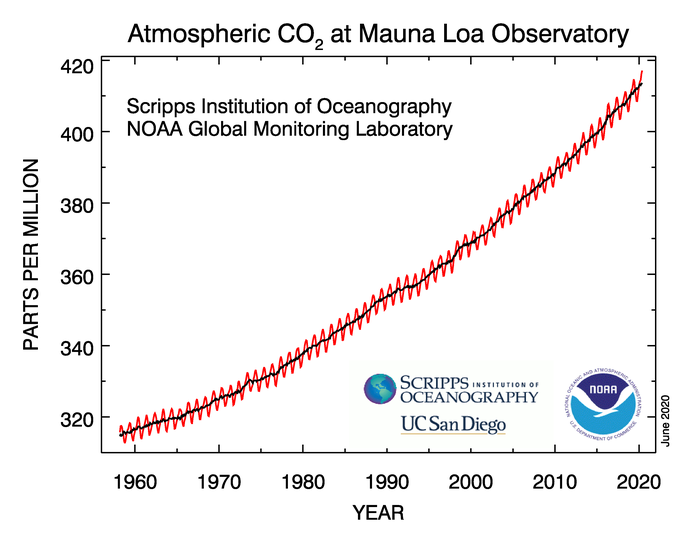Elevated levels of CO₂ and its Impact on Global Food Supply
By Aasritha Sanikommu, Innovation Lab 2022 Impact Intern
Food is essential and access to nutritious food is a basic human right. However, our access to nutritious food may be in danger in the upcoming years as anthropogenic climate change, climate change caused by human behavior, impacts carbon dioxide(CO₂) levels in our atmosphere, global temperatures, and precipitation patterns.
Effects of Human Activity on CO₂ and Temperature Levels
Humans have long burned fossil fuels such as coal, oil, and natural gas to generate energy. The resulting increased levels of CO₂ in the atmosphere have led to adverse changes in the living conditions for most of Earth’s population.
For instance, increased levels of CO₂ in the atmosphere have led to higher temperatures as a result of the greenhouse effect. Through the greenhouse effect, greenhouse gasses in the Earth’s atmosphere absorb the sun’s radiation and heat, preventing it from being reflected back into space. These increased temperatures can cause changes in the amount of evaporation that occurs, which can lead to severe changes in precipitation patterns. An important consideration is how elevated levels of carbon dioxide will affect our food supply.

Effects of Elevated Levels of CO₂ on Crops
Scientists have been working to study the effects of climate change on crops to understand more about the future of our food. They have done so by studying the effects of different temperatures and different levels of CO₂ on crops and have seen varying results. For instance, more CO₂ in the atmosphere may lead to higher crop yields due to an increase in the rate of photosynthesis and less water loss in crops. However, this positive outcome is only the case when increased levels of CO₂ is not combined with higher temperature levels, a common effect of climate change.
High levels of CO₂ when coupled with high temperatures have been shown to cause a significant decrease in pollen production, which leads to an overall decrease in a harvest’s yield. Increased levels of CO₂ do cause increased crop production as long as those crops are not also being exposed to extreme temperatures.
Effects of Elevated Levels of CO₂ on Nutrition
Higher levels of CO₂ will also lead to crops being less nutritious, with a noticeable decrease in zinc, iron, protein, and B vitamin levels.
Staple crops including rice and wheat are crops that will be less nutritious in the future. These staple crops sustain most of the Earth’s human population and animals, leading to a decrease in the nutrition levels of humans who eat both plant-based foods and animal-sourced foods. Decreases in the nutritiousness of staple foods may also lead to higher levels of infectious diseases, diarrhea, and anemia.
Although a lack of nutrients will be detrimental to humans everywhere, this issue will disproportionately affect the residents of Southeast Asia and Africa, who already experience higher levels of malnutrition and disease due to zinc and iron deficiencies.
Food Security and Our Food Supply Chains
Climate change will exacerbate problems that face the human population such as food security. In 2020, over thirty-eight million people in the United States were food insecure, and the effects of climate change will only make matters worse. Possible decreases in crop yields and crop nutrition will affect food security, availability, and affordability.
As farmers experience decreases in crop yields, they will be forced to raise prices for important crops such as wheat, maize, and soybeans. Increased prices of these crops mean a higher price tag on animal feed, which also leads to higher meat prices. Higher prices of staple crops and meat will reduce access to affordable food for much of the world’s population.
Moreover, our supply chains are more in danger than ever. With an increased likelihood of climate events damagingour supply chains, our food systems are more at risk. Examples of the frailty of our food system include the recent shortage in baby formula, the meat shortage during the COVID-19 pandemic, and more. Moments like these will be more common in the future.
The Future of Our Farms
As we look toward a future with an unpredictable climate and unreliable food production system, we must invest in technology that will optimize our farms and our food distribution systems.
Investments such as research into crop breeding to create climate-resistant crops are necessary. Agriculture may be able to adapt to a changing climate by using crop breeding to create new varieties of resistant crops. Plant breeding has huge potential to help crops adapt to climate change, as evidenced by historical and contemporary breeding experiences that show inherent heterogeneity within crops. In some cases, though, climate-resistant crops will not be enough.
Farmers will need to change the crops that are growing on their fields since the crops they are used to growing will experience low crop yields. Farmers will need to transition to crops that are better suited for the new temperatures, climate patterns, and carbon dioxide level changes that their regions will experience. These transitions will not occur without hardships. Farmers will require support from government entities and others in adapting to a new reality where the crops that used to be grown in one area no longer survive there.
As we look towards the future, we must acknowledge that our food production systems need to adapt to face supply shortages and a growing deficiency in nutritious content. This is a universal challenge that requires all the stakeholders to step up and make the required adjustments to ensure our access to nutritious foods.
Governments must incentivize farmers to make necessary changes to their farms to ensure access to nutritious foods, and they must invest in infrastructure so that the nutritious food being grown can be transported across our country. Researchers must focus their efforts on developing climate-resistant foods and other scientific research that will allow farmers to have the knowledge to better prepare themselves for changes they must make to their farms. Farmers must be open to changing many aspects of their farming practices including the crops they grow and their growing practices. Lastly, corporations must be able to track and bulk up their supply chains to ensure that a disaster in one location does not become a problem for all. All of these stakeholders must embrace and be ready to adapt to the changes that are coming in the future in order to ensure nutritious food for all.
Sources
Ebi, K. L., & Ziska, L. H. (2018). Increases in atmospheric carbon dioxide: Anticipated negative effects on Food Quality. PLOS Medicine, 15(7). https://doi.org/10.1371/journal.pmed.1002600
Gray, E. (2021, December 2). Global climate change impact on crops expected within 10 years, NASA study finds – climate change: Vital signs of the planet. NASA. Retrieved July 7, 2022, from https://climate.nasa.gov/news/3124/global-climate-change-impact-on-crops-expected-within-10-years-nasa-study-finds/
NASA. (2022, March 7). The causes of climate change. NASA. Retrieved July 7, 2022, from https://climate.nasa.gov/causes/#:~:text=Over%20the%20last%20century%20the,air%20to%20make%20CO2.
Nelson, G. C., Rosegrant, M. W., Koo, J., & Robertson, R. D. (2009). Climate change: Impact on agriculture and costs of adaptation. Ifpri.org. Retrieved July 7, 2022, from https://www.ifpri.org/publication/climate-change-impact-agriculture-and-costs-adaptation
Prasad, P. V. V., Boote, K. J., & Allen, L. H. (2006). Adverse high temperature effects on pollen viability, seed-set, seed yield and harvest index of grain-sorghum [sorghum bicolor (L.) moench] are more severe at elevated carbon dioxide due to higher tissue temperatures. Agricultural and Forest Meteorology, 139(3-4), 237–251. https://doi.org/10.1016/j.agrformet.2006.07.003
Reiny, S. (2016, May 3). Rising carbon dioxide levels will help and hurt crops. NASA. Retrieved July 7, 2022, from https://www.nasa.gov/feature/goddard/2016/nasa-study-rising-carbon-dioxide-levels-will-help-and-hurt-crops
Thomspon, M., Gamage, D., Hirotsu, N., Martin, A., & Seneweera, S. (2016). Elevated atmospheric carbon dioxide: Root Growth. Elevated Carbon Dioxide, 115–134. https://doi.org/10.1201/b10812-8
US EPA. Climate Impacts on Agriculture and Food Supply | Climate Change Impacts | US EPA. (n.d.). Retrieved July 7, 2022, from https://climatechange.chicago.gov/climate-impacts/climate-impacts-agriculture-and-food-supply
White, K., Tamara Wagester, T., & Glasener, D. K. M. (n.d.). How will climate change affect agriculture? . Soils. Retrieved July 7, 2022, from https://www.soils.org/files/science-policy/caucus/briefings/climate-change.pdf
About the Author:
 Aasritha Sanikommu, Innovation Lab 2022 Impact Intern
Aasritha Sanikommu, Innovation Lab 2022 Impact Intern
Aasritha is originally from Pennsylvania and is now a student at the University of Maryland. She is studying Computer Science and is pursuing a Business Analytics minor. She is also very interested in entrepreneurship and sustainability, and hopes to expand these passions as an intern at Bethesda Green!





